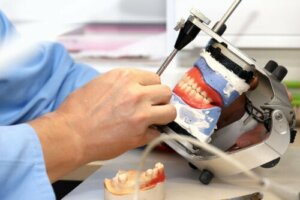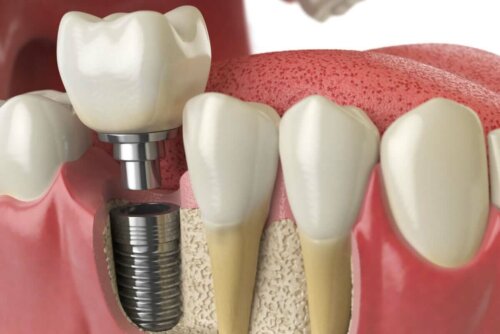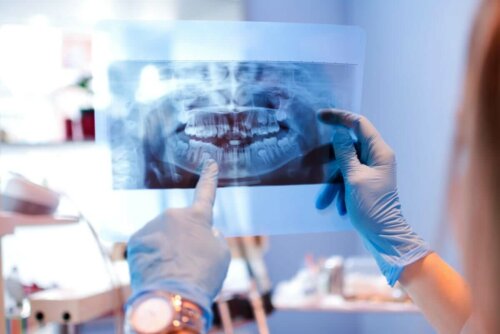Dental Implant Prosthetics: What They Are and the Different Types Available


Written and verified by the dentist Vanesa Evangelina Buffa
Missingone or more teeth doesn’t just aesthetically change a person, but it can also affect how their mouth works. Dental implant prosthetics are a good option when it comes to replacing these missing teeth, and many people consider them to be comfortable and stable.
This kind of denture is defined as being fixed and kept in place by a dental implant. Specialists place these titanium screws into the maxillary bone or jaw. For its biocompatibility, the metal sits in the bone tissue. This acts as a point of grip for a crown or a bigger prosthetic.
In this article, we explain what types of prosthetics exist and in what circumstances specialists would fit them. We also look at how they do this, and the advantages of having one.
Types of prosthetics and their benefits
Dental implant prosthetics are structures that contain artificial teeth and they replace any that have been lost. They fix onto implants that specialists have inserted into the jaw. They’re different from conventional dentures as they stay in their position; not only because of their close contact with the gums but also because of the metal screws in the bone.
There are many benefits that these dentures provide someone who has chosen to rehabilitate their mouth in this way:
- Stability: Usually, these prosthetics don’t move much or at all. You can talk and chew without the prosthetic coming loose or moving, even when you eat hard or sticky foods.
- Comfort: If the prosthetic is fitted properly and has less friction with mucus membranes, you’ll get used to having the denture and can naturally use your mouth.
- Bone conservation: Both the presence of implants in the bone tissue and the stimuli the prosthesis generates help to retain bone mass. In turn, this prevents the loss of bone mass.
- Naturalness: This rehabilitation method is the most similar to the dental structure because it brings back the coronary portion of the teeth and the root. The latter is because the prosthetic uses a part that has been fitted within the bone.
- Recuperation of function: You’re able to recover your ability to chew, speak, and swallow. All of these may have been changed by the lack of teeth. Additionally, you’ll also get the aesthetic aspect of your smile back.
- Many possibilities depending on the specific case: There are different dental implant prosthetics. For example, they vary according to whether the patient in question may have taken the teeth out themselves, or according to the number of teeth that need to be replaced.

Fixed prosthetics
Specialists either cement or screw in dental implant prosthetics to several implants already within the bone. As the name suggests, people with these kinds of implants can’t remove them.
These structures replace teeth from the maxillary or jaw bone using a reduced amount of implants. Specialists insert them into the specially chosen areas to give support to the structure. They’re then capable of doing the same biometric functions that the roots of the natural teeth do.
They’re smaller than traditional dentures. This is because they only use the dental part, without pink gums, which is typical of other kinds of prosthetics. In general, specialists will use 8 implants for the upper maxillary bone and 4 for the jaw, but this depends on each case.
Each design is personalized according to the patient’s needs and possible circumstances, which allows designers to use different materials. The most common prosthetics are made from metal and ceramic, which is similar to porcelain.
At the moment, there are also zirconia variants. This is a hard ceramic that’s very resistant but looks natural. As they’re only comprised of teeth that are screwed or cemented in over the implants, they go almost unnoticed and are very comfortable for the person wearing them.
Overdenture
Overdentures are a type of dental implant prosthetic similar to more traditional dentures. The only difference is that they use screws in the bone as anchors. This strong bond between the denture with implants in the bone will give you security and comfort when you’re chewing and talking.
This kind of prosthetic requires fewer implants than a fixed prosthetic. Generally speaking, just 4 in the maxillary bone and 2 or 3 in the jaw are enough. For that reason, overdentures are an ideal alternative for patients with bone tissue loss.
These implants are screw-in anchoring systems that specialists insert into the denture when fitting it. With this special system, you’ll be able to fit it and remove it, but it has much better retention. For example, you can take them out yourself to clean them and later replace them to eat.
Hybrid
This kind of denture uses the support the implants and the gum mucus offer. These screw into the implants and only a dentist can remove them.
These have both a dental and a pink gum portion, providing a replacement for both any lost teeth and soft tissue. Specialists recommend these to patients with noticeable bone reabsorption. Hybrids use 6 implants in the upper maxillary bone and 4 in the lower.
Unlike fixed prosthetics, specialists make hybrid dentures with the latest acrylic or combined materials, like conventional dentures. This is why they look a lot more artificial. Either way, though, they provide aesthetic, security, and comfort to the person.
According to the number of teeth
There’s another classification of dental implant prosthetics which takes into account the number of teeth that need replacing. They are as follows:
- Unitary: These kinds just replace one missing tooth. This is the only artificial tooth that’s fixed to an implant. It returns the aesthetic and natural harmony to the mouth.
- Partial: Prosthetics like these substitute several missing teeth and are fixed.
- Total: These dentures replace all the teeth in the mouth, either the top or bottom sets or even both. People that no longer have their own teeth tend to use this kind. They can be fixed, removable, or hybrids. This all depends on the choice or case of the individual.
Also read: Dental Bridge: Types, Benefits, and Disadvantages
What’s the process?
Planning and placing a dental implant prosthetic is a slow and lengthy process. You should consider what the diagnostic and the healing phase are.
It’s important you undergo a full diagnostic period with clinical studies and exhaustive x-rays before you have the implant fitted. This helps the specialist to fully understand the density and quality of the bone where the screws will eventually be fitted.
After all that, you’re ready for a specialist to fit the implants. This is a surgical process wherein you’ll be under local anesthetic, and the dentist inserts the screws into the bone tissue.
You’ll need between 2 and 6 months for the titanium implant to fuse to the bone, and form a strong bond that will support the burden of the dentures. According to the type of prosthetic you’ll have, you may require additional surgery to find the implants and add extensions or locate them. After this, you’ll be able to use dentures immediately with guidance.
When the implants are ready, with their specific connection devices according to the kind of prosthetic, they’re sent off to be specially made. Then, once they’re made and tested, the specialist fits them into the patient’s mouth.
The dentist will then cement – or screw if it’s a fixed or hybrid prosthetic – these in. If the patient requires overdentures, the dentist will show the patient how to fit them and remove them. Furthermore, they’ll show the patient how to care for them and how to use them correctly.

You may also be interested in: Strengthen Your Bones and Alleviate Pain in Your Joints With This Natural Drink
Who do specialists recommend having dental implant prosthetics?
Dental implant prosthetics are a good idea for replacing teeth that have been lost for different reasons. Specialists recommend these for patients who don’t have teeth on their maxillary or jaw bone, or both, and have moderate bone loss.
They’re ideal for those who don’t feel comfortable with traditional dentures, mainly because they’re uncomfortable or they worry that the denture will fall out. They help to avoid self-esteem problems, increasing the patient’s confidence.
Care and advice for dental implant prosthetics
Dental implant prosthetics are a more permanent solution that helps people who are missing teeth to be able to chew, eat, speak, and smile with security and confidence again. Beyond the type they chose, maintenance and care are vital for the procedure’s success.
Brushing your teeth, tongue, and gums with a soft-bristled toothbrush is important. If necessary, you can also sometimes complement this with mouthwash.
When it comes to overdentures, taking them out and cleaning them after you eat is also essential. When you’re not using them, you can place them in a glass of clean water in a safe place.
Additionally, periodic visits to the dentist can help to ensure that everything goes well. So, by using dental implant prosthetics responsibly, you can start smiling, eating, and speaking with confidence again!
All cited sources were thoroughly reviewed by our team to ensure their quality, reliability, currency, and validity. The bibliography of this article was considered reliable and of academic or scientific accuracy.
- González, Fabián Pérez, et al. “Criterios de selección para sistemas de retención en sobredentaduras mandibulares implantorretenidas sobre dos implantes.” Revista internacional de prótesis estomatológica 19.1 (2017): 7-12.
- Berro, Mariela, María Laura Samprón, and Emanuel Ricardo Tomaghelli. “Rehabilitación sobre implantes: Sobredentadura.” IV Jornadas de Actualización en Prácticas Odontológicas Integradas PPS-SEPOI (La Plata, 7 de julio de 2020). 2020.
- Barreto, A. P., et al. “Sobredentadura mandibular:: opción de tratamiento rehabilitador.” Acta odontológica venezolana 55.1 (2017): 39-40.
- Díaz Sarabia, Edinson Antonio, and José Antonio Balarezo Razzeto. “Tipos de prótesis sobre implantes en pacientes edéntulos planificados en la Clínica Dental Docente de la Universidad Peruana Cayetano Heredia.” (2019).
- Díaz Reyes, Kusi Yveth. “Prótesis híbridas sobre implantes dentales, indicaciones, protocolo de manejo clínico y laboratorio.” (2017).
- Zabalbú, Sirhua, and Jazmín Nozhatú. “Prótesis híbrida en pacientes edéntulo total.” (2017).
- Navarro, Iván, et al. “Rehabilitación oral maxilar y mandibular con prótesis híbridas, utilizando implantes convencionales de una y dos fases e implantes zigomáticos en paciente con displasia ectodérmica. Caso clínico.” Odontología Vital 29 (2018): 77-83.
- Villafuerte, Rolando F. Dau, Elizabeth C. Ortiz Matias, and Veronica R. Huacon Cherrez. “Eficacia del tratamiento con injerto óseo, prótesis fija e implantes en paciente con reabsorción del reborde óseo maxilar.” Dominio de las Ciencias 3.2 (2017): 33-45.
- Angulo-Serrano, Aldo, Diana Quijandria-Briceño, and Sergio Alvarado-Menacho. “Rehabilitación Integral de un paciente con reabsorción ósea horizontal, mediante regeneración ósea guiada simultánea a la colocación de implantes.” Revista Estomatológica Herediana 28.2 (2018): 115-124.
This text is provided for informational purposes only and does not replace consultation with a professional. If in doubt, consult your specialist.








